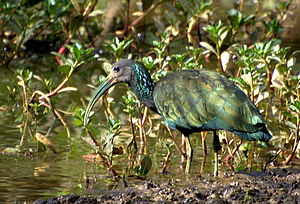Grünibis
| Grünibis | ||||||||||
|---|---|---|---|---|---|---|---|---|---|---|

Green ibis ( Mesembrinibis cayennensis ) |
||||||||||
| Systematics | ||||||||||
|
||||||||||
| Scientific name of the genus | ||||||||||
| Mesembrinibis | ||||||||||
| JL Peters , 1930 | ||||||||||
| Scientific name of the species | ||||||||||
| Mesembrinibis cayennensis | ||||||||||
| ( Gmelin , 1789) |
The green ibis or Cayenneibis ( Mesembrinibis cayennensis ) is a medium- and South American bird from the family of ibises and spoonbills . It is in the monotypical genus Mesembrinibis .
Appearance
The green ibis reaches a body length of 48 to 58 cm, the weight is between 715 and 785 g. The plumage and the curved beak are black with a green-metallic sheen, which can be more or less pronounced depending on the light conditions. The legs are dark gray.
There is no pronounced gender dimorphism . The plumage of the young birds is markedly duller in color, without the metallic sheen.
Distribution and existence
The green ibis is native to South and Central America. It occurs in Nicaragua , Honduras , Costa Rica , Panama , Colombia , Venezuela , Guayana , in the eastern parts of Ecuador , Bolivia and Peru , in almost all of Brazil up to Paraguay and northeast Argentina .
According to IUCN there are 50,000 to 100,000 breeding pairs worldwide, the species is classified as not endangered .
habitat

The green ibis prefers wooded and moist biotopes, mangrove swamps , river and lake banks, also open grassland near the forest.
nutrition
The food of the green ibis consists of insects and their larvae, worms and snails, but also has vegetable parts. To search for food, it pokes its beak in the soft ground or in shallow water. Sometimes he also opened his wings, possibly to improve visibility.
Reproduction
The green ibis does not breed in colonies. The individual nests are built on tall trees, often over bodies of water. Twigs are used as nest building material, grass and leaves are used for padding. The clutch consists of 2 to 4 eggs. The young birds fledge in 23 to 27 days.
literature
- J. del Hoyo, A. Elliott, J. Sargatal (Eds.) (1992): Handbook of the Birds of the World . Vol. 1. Ostrich to Ducks. Lynx Edicions, Barcelona, ISBN 84-87334-10-5
Web links
- Mesembrinibis cayennensis in the endangered Red List species the IUCN 2008. Posted by: BirdLife International, 2008. Accessed on March 1 of 2009.
- BirdLife Species Factsheet
- Videos, photos and sound recordings of Mesembrinibis cayennensis in the Internet Bird Collection